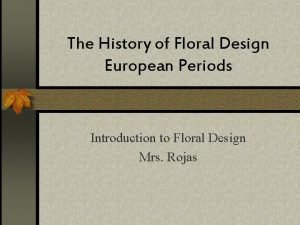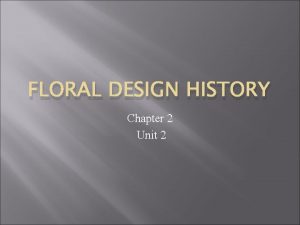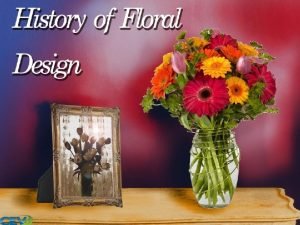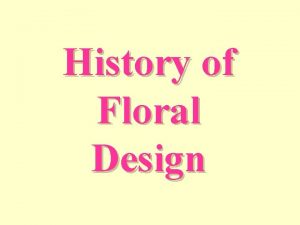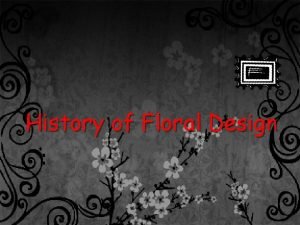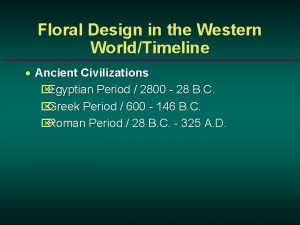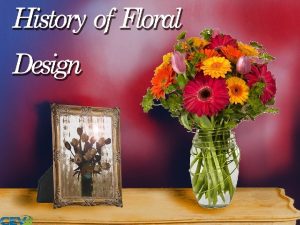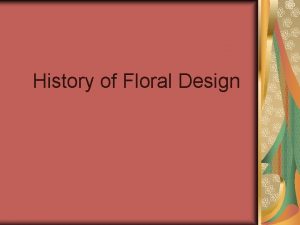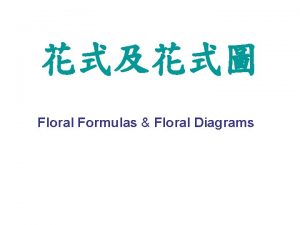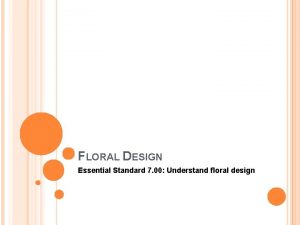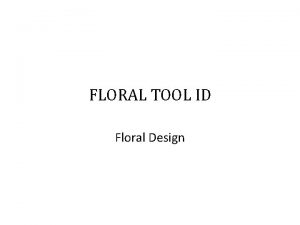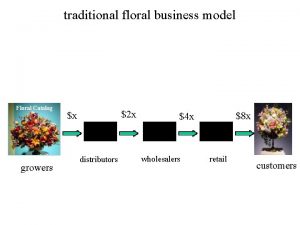The History of Floral Design European Periods Introduction

















- Slides: 17

The History of Floral Design European Periods Introduction to Floral Design Mrs. Rojas

Middle Ages n Flowers (both wild and cultivated) were an important part of everyday life n Used in food, drink, and medicine n Fragrant flowers were favored for the ground, freshening the air, and making wreaths and garlands for personal adornment and decoration

Middle Ages

Renaissance n Art represented religious history – flowers in vases were shown in paintings for symbolism A rose represented sacred or profane love n A white lily was the symbol for chastity and fertility n Single stems of white lilies in a humble jug was popular n n Flowers were arranged in vases so only the blossoms were visible and the stems were covered, creating massed, symmetrically stiff, conical arrangements n Varieties of bright colors and forms were used

Renaissance n Wreaths & garlands were still common n Containers were pattered after Greek and Roman periods, using elaborate metal containers with well-formed bases, stems, necks, and handles n Many containers had removable lids with holes in them to hold stems

Renaissance

Baroque & Dutch-Flemish Styles n Art became accessible to middle class instead of just church and nobility n Flower arrangements were sent in everyday situations n Elaborate ornamentation and curved lines were used n Oval shape, asymmetrical balance, and S-curve designs were all used in arrangements n Over-decoration and gaudy interiors were common n Flower paintings showed creative expression in large, flamboyant arrangements n Containers included glassware, terra cotta, and porcelain

Baroque & Dutch-Flemish Styles

French Period n Emphasis was on classic form, refinement, and elegance n Arrangements were commonly fanshaped or triangle and massed, used as decorative accents in interiors n Vases were highly ornate (decorated), portraying elegance, and tasteful extravagance

French Period

English – Georgian Period n Fragrance was the most important part of a bouquet, believing that perfume would rid the air of contagious and infectious diseases n Nosegays were created to keep flowers close by and relieve the smells of unsanitary surroundings n Cleanliness was not a high standard in their living n Flowers were worn in hair and around necks or on gowns, either at waist or the shoulder

English – Georgian Period n Arrangements were formal and symmetrical, arranged with a variety of flowers n Flower–filled containers were set by fireplaces when heat wasn’t necessary n called a bough-pot n Wedgwood and fine ceramic containers were used for expensive arrangements n Miniature arrangements in bud vases

English – Georgian Period

Victorian Era n Flower arranging was taught and recognized as an art n Girls were taught to arrange, grow, preserve, press, draw, and paint flowers, including making artificial flowers n Arrangements grouped large masses of flowers, foliage, and grasses together for compact designs without voids n Design shapes were oval or round n Nosegays and hand bouquets were popular, conveying special sentiments with specific flowers

Victorian Era n Containers were highly ornate and showy, using all materials and shapes for holding abundant masses of flowers n Posy holders were invented using various materials n Formal (concentric rings of flowers with a symbolic flower in the center) and informal (casual mixing of fragrant blossoms) nosegay designs were used n Bosom bottles (aqua-picks) were formed to keep flowers fresh and from withering, when they were worn

Victorian Era

Victorian Era
 European floral design history
European floral design history Art nouveau floral design history
Art nouveau floral design history Middle ages flower arrangements
Middle ages flower arrangements European floral design history
European floral design history Floral design floral pricing worksheet
Floral design floral pricing worksheet Periods of european literature
Periods of european literature Soe definition floral design
Soe definition floral design The history of floral design
The history of floral design Style occidental
Style occidental Egyptian floral design
Egyptian floral design Flemish floral design
Flemish floral design Inverted t floral arrangement
Inverted t floral arrangement Periods in roman history
Periods in roman history European music history
European music history Four periods of history
Four periods of history Four basic computing periods
Four basic computing periods 3 periods of history
3 periods of history 3 periods of history
3 periods of history
